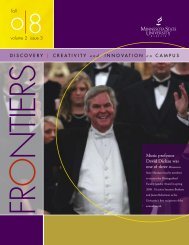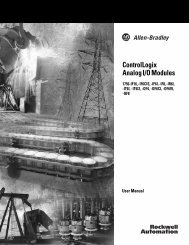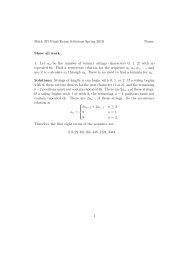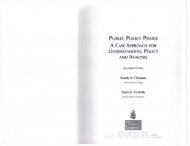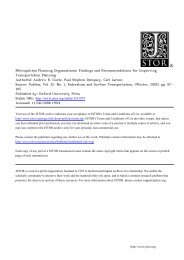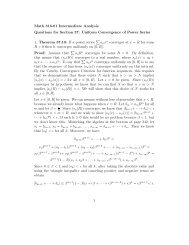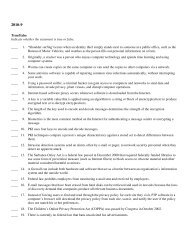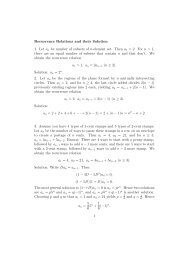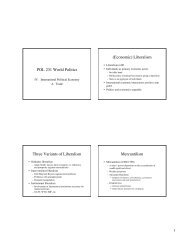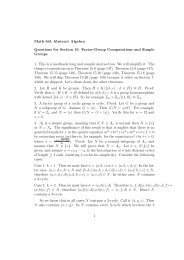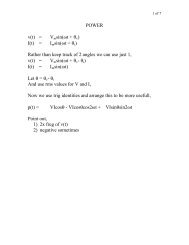The County Supremacy and Militia Movements ... - MavDISK
The County Supremacy and Militia Movements ... - MavDISK
The County Supremacy and Militia Movements ... - MavDISK
You also want an ePaper? Increase the reach of your titles
YUMPU automatically turns print PDFs into web optimized ePapers that Google loves.
<strong>The</strong> <strong>County</strong> <strong>Supremacy</strong> <strong>and</strong> <strong>Militia</strong> <strong>Movements</strong>: Federalism as an Issue on the Radical Right<br />
Author(s): William Chaloupka<br />
Source: Publius, Vol. 26, No. 3, <strong>The</strong> State of American Federalism, 1995-1996, (Summer, 1996),<br />
pp. 161-175<br />
Published by: Oxford University Press<br />
Stable URL: http://www.jstor.org/stable/3330626<br />
Accessed: 18/08/2008 17:48<br />
Your use of the JSTOR archive indicates your acceptance of JSTOR's Terms <strong>and</strong> Conditions of Use, available at<br />
http://www.jstor.org/page/info/about/policies/terms.jsp. JSTOR's Terms <strong>and</strong> Conditions of Use provides, in part, that unless<br />
you have obtained prior permission, you may not download an entire issue of a journal or multiple copies of articles, <strong>and</strong> you<br />
may use content in the JSTOR archive only for your personal, non-commercial use.<br />
Please contact the publisher regarding any further use of this work. Publisher contact information may be obtained at<br />
http://www.jstor.org/action/showPublisher?publisherCode=oup.<br />
Each copy of any part of a JSTOR transmission must contain the same copyright notice that appears on the screen or printed<br />
page of such transmission.<br />
JSTOR is a not-for-profit organization founded in 1995 to build trusted digital archives for scholarship. We work with the<br />
scholarly community to preserve their work <strong>and</strong> the materials they rely upon, <strong>and</strong> to build a common research platform that<br />
promotes the discovery <strong>and</strong> use of these resources. For more information about JSTOR, please contact support@jstor.org.<br />
http://www.jstor.org
<strong>The</strong> <strong>County</strong> <strong>Supremacy</strong> <strong>and</strong><br />
<strong>Militia</strong> <strong>Movements</strong>: Federalism<br />
as an Issue on the Radical Right<br />
William Chaloupka<br />
University of Montana<br />
This article reviews two of the most visibleforms of the populist right resurgence in Amercan politics,<br />
the county rule <strong>and</strong> militia movements. Both of these efforts have phrased their claims in the terms of<br />
federalism, constitutionalism, <strong>and</strong> sovereign legitimacy-terms that have not often been so prominently<br />
identified with such radical organizing. <strong>The</strong> essay reviews the origins of both county rule <strong>and</strong> militia<br />
movements, as well as their activities during 1995. <strong>The</strong> article reviews the arguments of each movement<br />
relating to American federalism. <strong>The</strong> county rule movement denies federal ownership of l<strong>and</strong>s, among<br />
other activities. <strong>The</strong> militias challenge the governmental monopoly on the use offorre, drawuing upon a<br />
tradition of "militia " conscription in early American history. Neither argument has fared well in several<br />
lawsuits, but the political appeal has been significant.<br />
Even before the Oklahoma City bombing in April 1995, observers knew<br />
that a new, populist right-wing turn had taken place, especially in the western<br />
states. As intense media coverage subsequently revealed, radical anti-<br />
government groups had grown rapidly. At least on the movement's margins,<br />
its capacity for violence had also exp<strong>and</strong>ed. In this essay, I review two of the<br />
most visible forms of this populist <strong>and</strong> rightist turn, the county rule <strong>and</strong><br />
militia movements. Both of these efforts have phrased their claims in the<br />
terms of federalism, constitutionalism, <strong>and</strong> sovereign legitimacy- terms that<br />
have not often been so prominently identified with such radical organizing.<br />
It is difficult to assess even the approximate strength of these movements.<br />
Proponents issue improbably high estimates, for obvious reasons.<br />
Law enforcement tends to offer low estimates, perhaps due to the intermittent<br />
character of their attention to these groups. Individuals <strong>and</strong> organizations<br />
dedicated to monitoring the movement offer various estimates. Since the<br />
movements are often secretive, no reliable count is possible. This much is<br />
clearer about the strength of the populist right; the movement has captured<br />
significant attention in local <strong>and</strong> national media, it has sometimes set<br />
the agenda of legislative debate, <strong>and</strong> its most adamant fringe has proven<br />
capable of remarkable violence.<br />
? Publius: <strong>The</strong> Journal of Federalism 26:3 (Summer 1996)<br />
161
162<br />
Publius/Summer 1996<br />
One estimate of the movement's strength st<strong>and</strong>s out. Soon after the<br />
Oklahoma bombing, the Washington Post <strong>and</strong> ABC News conducted a poll<br />
that addressed issues of the new right radicalism.' Although surveys have<br />
shown that support for these groups has withered since the Oklahoma bomb-<br />
ing, the level of support identified in this poll was extraordinary. <strong>The</strong> poll's<br />
summary offered this assessment of the support for extreme movements;<br />
"Thirteen percent of Americans support private armed militias...Twelve<br />
percent are afraid of the government, 9 percent are angry at it, nine percent<br />
say violence against it can be justified, <strong>and</strong> six percent call it their<br />
'enemy."' Almost apologetically, the poll summary explained that "Six<br />
percent, while a small share is 11 million adults."<br />
While many political centrists have emphasized the general decline of<br />
public trust <strong>and</strong> confidence in government in recent decades, the radical<br />
right has elaborated those sentiments, producing several gradations of<br />
antigovernment ideology. This essay begins with overviews of both the county<br />
movement <strong>and</strong> the militias, before turning to a discussion of their similarities<br />
<strong>and</strong> differences <strong>and</strong> a review of their constitutional <strong>and</strong> federalist arguments.<br />
COUNTY MOVEMENT OVERVIEW<br />
In the lexicon of the new rightist radicalism, "the county movement" refers<br />
to a loosely organized network of groups <strong>and</strong> individuals that promotes<br />
increased power for county government <strong>and</strong> decreased federal authority,<br />
especially over public l<strong>and</strong>s. This new county movement is an offshoot of<br />
the anti-environmentalist "Wise Use" movement, itself a reinvigorated progeny<br />
of the antigovernment Sagebrush Rebellion that attracted much attention<br />
in the late 1970s <strong>and</strong> early 1980s.2 (<strong>The</strong> county movement has nothing<br />
to do with the more commonplace discussion of county prerogative to set<br />
tax rates <strong>and</strong> take other action independent of state government, a debate<br />
long known as the "county home rule" issue. Accordingly, I will refer to the<br />
current activity as the "county movement," although it is also sometimes<br />
known as the "county sovereignty movement," the "county rule" movement,<br />
or simply Sagebrush Rebellion II.)<br />
Monitoring groups point to Catron <strong>County</strong>, New Mexico, as the site of<br />
the beginning of the county movement.3 This sparsely populated rural<br />
county, located in the state's desert southwest, first passed "county rule"<br />
"'Distrust of Government," ABC News/Washington Post Poll, 17 May 1995. Posted to America Online<br />
(keywords ABC/NEWS/POLLS), transcript ab5np036-7.<br />
2For a comprehensive Wise Use review, see Phil Brick, "Determined Opposition: <strong>The</strong> Wise Use Move-<br />
ment Challenges Environmentalism," Environment 37 (October 1995): 16-28.<br />
'DanielJunas, "Rise of Citizen <strong>Militia</strong>s," Covert Action Qunrlerly 52 (Spring 1995): 14-20. See Netscape<br />
version: http://www.worldmedia.com/caq/militia.html (27January 1996).
<strong>The</strong> <strong>County</strong> <strong>Supremacy</strong> <strong>and</strong> <strong>Militia</strong> <strong>Movements</strong> 163<br />
ordinances in 1991.4 Ordinances were passed asserting county precedence<br />
over federal authority in environmental planning; declaring that federal graz-<br />
ing permits were private property; outlawing reintroduction of wolves, bears,<br />
or cougars; <strong>and</strong> threatening the arrest of any federal official who objected<br />
to these measures.5 Nye <strong>County</strong>, Nevada, has also been the source of ordi-<br />
nances copied by other western counties. Nye's ordinance denies federal<br />
authority "to own, hold, or exert its dominion over any public l<strong>and</strong>s except<br />
for whatever l<strong>and</strong> it needs for its own governmental purpose," presumably<br />
including military bases.6<br />
Nye <strong>County</strong> gained national visibility when a group, led by a county<br />
commissioner, acted on its ordinance staging a confrontation in which two<br />
forest rangers faced perhaps two hundred protesters. A road, that the Forest<br />
Service had closed for repairs, was bulldozed open at the protest.7 When<br />
the United States Department of Justice filed suit against Nye <strong>County</strong> on<br />
8 March 1995, it explicitly did so in order to challenge other counties' anti-<br />
federal ordinances, as well as Nye's ordinances. AJustice Department spokes-<br />
man explained, "One of the purposes of this lawsuit was to send a message<br />
to counties everywhere that the arguments behind this kind of action have<br />
no legal merit. We're filing it in the one county that's done the most to<br />
enforce [an anti-federal l<strong>and</strong>s ordinance]."8<br />
Many other counties are involved; as many as fifty-eight western counties<br />
have passed ordinances similar to those enacted in Nye <strong>and</strong> Catron.9 Bills<br />
reflecting the county movement's concerns have also been introduced in<br />
several state legislatures <strong>and</strong> in the Congress, albeit without much success.10<br />
Sometimes, the protests have focused on county official actions, rather than<br />
on legislation. In Owyhee <strong>County</strong>, Idaho, a respected county sheriff with<br />
twenty-four years in office announced that his county was off-limits to federal<br />
law enforcement activity, notifying the Bureau of L<strong>and</strong> Management (BLM)<br />
'Kenneth S. Stern, A Force Upon the Plain: <strong>The</strong> American <strong>Militia</strong> Movement <strong>and</strong> the Politics of Hate (New<br />
York: Simon & Schuster, 1996), pp. 122-123. <strong>The</strong> first legal test of a county supremacy ordinance<br />
occurred in Lincoln <strong>County</strong> (NM) v. United States, 1992, which was dropped when the Bureau of L<strong>and</strong><br />
Management issued a letter promising to cooperate with the county. SeeJim Carrier, "Rebels Ride Again:<br />
Nevadans Take On Federal Sovereignty," Denver Post, 21 January 1996, pp. Al, A16.<br />
5Paul Rauber, "National Yard Sale: Threats to Federal Ownership of Public L<strong>and</strong>s," Sierra 80<br />
(September/October 1995): 28-31, <strong>and</strong> Paul Rauber, "Wishful Thinking: Wise Use Cowboys Try to<br />
Rewrite the Constitution," Sierra 79 (January/February 1994): 39-42.<br />
'Rauber, "National Yard Sale," 28.<br />
7<strong>The</strong> episode led to a CBS "48 Hours" segment <strong>and</strong> a Time cover story. Erik Larson, "Unrest in the<br />
West," Time 146 (October 1995): 52-66. See also Richard Reinhardt, "Nevada: a Phony Showdown with<br />
Real Guns" Wilderness 59 (Winter 1995): 11.<br />
'Valerie Richardson, "Westeri Counties Dare Washington to Enter L<strong>and</strong> Duel," Washington Times,<br />
2 April 1995, p. A7.<br />
'Rauber, "National Yard Sale," 28.<br />
"For example, bills have been introduced in the Congress by Senator Craig Thomas (R-WY),<br />
Representative James V. Hansen (R-UT), <strong>and</strong> Senator Conrad Burns (R-MT) that would have forced the<br />
BLM to divest some l<strong>and</strong> holdings <strong>and</strong> face severe budget cuts. Valerie Richardson, "On Western Range,<br />
BLM is Hated Federal Regulator," Washington Times, 15 October 1995, p. Al. For example, Arizona<br />
bankrolled a $1 million fund (called the "Constitutional Defense Council") to finance lawsuits against<br />
federal law enforcement officials, <strong>and</strong> considered a bill that would have imposed a $500 bounty on any<br />
endangered Mexican wolves that might be reintroduced by federal agencies; "Arizona Leads Fight Against<br />
Federal Regs," Washington Times, 10 March 1995, p. A10.
164<br />
Publius/Summer 1996<br />
that they no longer had authority to act as armed officers of the law. <strong>The</strong><br />
sheriff was criticized in a newspaper editorial that complained that this<br />
"distinguished <strong>and</strong> seasoned officer" was now, sadly, "sucking up to the<br />
anger of the moment" <strong>and</strong> acting like "some ill-informed crank out in the<br />
boonies. "'<br />
Like Nye <strong>and</strong> Catron, most of the prominent counties in the movement<br />
are rural, low population counties in the West, where a large proportion of<br />
the l<strong>and</strong> is federally owned. In Nye <strong>County</strong>, 93 percent of the l<strong>and</strong> is federally<br />
owned. A dramatic mismatch exists between the federal government with<br />
its considerable administrative capacity, on one h<strong>and</strong>, <strong>and</strong> these countieswhich<br />
often possess minuscule governmental infrastructure-on the other.<br />
<strong>The</strong> political logic of these disputes is complicated by the fact that so much<br />
of the dispute centers around grazing rights <strong>and</strong> fees. While some ranchers<br />
argue for less government involvement in regulating grazing on public l<strong>and</strong>s,<br />
others contest the possible threat of higher federal grazing fees (fees which<br />
environmentalists claim are much lower than the markets would set)."1 In<br />
a sense, the latter group is hoping for return to an earlier, more lucrative<br />
era of federal involvement.<br />
Some observers believe that the contemporary county movement will be<br />
more persistent than its predecessor, the Sagebrush Rebellion. That earlier<br />
initiative quickly disappeared-a victim, in one scholar's view, of diffusion in<br />
the wake of political gains (including President Ronald Reagan's appointment<br />
of James Watt as Secretary of the Interior) combined with resistance<br />
within the administration to the idea of privatizing (or "conveying" to the<br />
states for privatization) federal l<strong>and</strong>s, an idea the original Sagebrush Rebels<br />
had never pushed, but were nonetheless identified with in the press.13<br />
Rancher Hugh McKeen, a Catron <strong>County</strong> commissioner, says, "this<br />
rebellion, this time, this one will go to the end. It's going to be Civil War if<br />
things don't change."14 <strong>The</strong> BLM has taken threats against its agents seri-<br />
ously enough to issue a "<strong>County</strong> <strong>Supremacy</strong> Safety Ordinance," ordering<br />
field agents to observe precautions such as notifying supervisors of travel<br />
plans: "Do not leave the BLM compound without radio communications<br />
capability....Avoid areas with a known potential of conflict."'5 <strong>The</strong> Justice<br />
"Valerie Richardson, "No-nonsense Idaho Sheriff Tells Federal Law Officers to Stay Out," Washington<br />
Times, 27 August 1995, p. Al.<br />
'2For examples of lawsuits over grazing rights issues, see Cliff Gardner v. United States, 1994-1995 (United<br />
States District Court affirmed the federal practice of issuing grazing permits on U.S. forest l<strong>and</strong>), Hat<br />
Ranch v. United States, 1995 (Otero <strong>County</strong>, New Mexico rancher tried unsuccessfully to pay federal<br />
grazing fees to his county government), <strong>and</strong> Simplot Livestock <strong>and</strong> Bell v. United States, 1995 (United States<br />
District Court confirmed the Forest Service's authority to change riparian st<strong>and</strong>ards on grazing permits,<br />
<strong>and</strong> as appealed). See Carrier, "Rebels Ride Again," A16.<br />
"3R. McGreggor Cawley, Federal L<strong>and</strong>, Western Anger: <strong>The</strong> Sagebrush Rebellion <strong>and</strong> Environmental Politics<br />
(Lawrence, KS: University of Kansas Press, 1993), pp. 123-142.<br />
4Vince Bielski, "Armed <strong>and</strong> Dangerous: <strong>The</strong> Wise Use Movement Meets the <strong>Militia</strong>s," Sierra 80<br />
(September/October 1995): 33-35.<br />
15Rauber, "National Yard Sale," 28.
<strong>The</strong> <strong>County</strong> <strong>Supremacy</strong> <strong>and</strong> <strong>Militia</strong> <strong>Movements</strong><br />
Department took the Catron <strong>County</strong> sheriff seriously when he threatened<br />
to arrest the head of the U.S. Forest Service;Justice in turn threatened the<br />
sheriff with arrest.'6<br />
Although the confrontational atmosphere that once prevailed in Catron<br />
<strong>County</strong> has reportedly calmed,'7 it would seem that there are enough<br />
resolute activists in Nevada <strong>and</strong> elsewhere to keep the movement alive. But<br />
whether the radical margins of the county movement retain their vitality, a<br />
more mainstream movement to defend <strong>and</strong> exp<strong>and</strong> states' rights has been<br />
gathering momentum. No less mainstream a figure than the director of<br />
the National Conference of State Legislatures' Washington, D.C., office published<br />
an extensive study of developments in state legislatures-including<br />
initiatives such as Charlie Duke's Colorado legislation <strong>and</strong> other measures<br />
usually grouped.with the county <strong>and</strong> Wise Use movements. This study, published<br />
in NCSL's State Legislatures, concluded that "the movement to restore<br />
the balance may succeed in any event. It could succeed because so many<br />
state officials are angry <strong>and</strong> believe there is a chance-that may not come<br />
again-to do it now."'8<br />
MILITIA OVERVIEW<br />
165<br />
Kenneth S. Stern, the American Jewish Committee researcher whose book<br />
provides the most comprehensive view of the current situation in print,<br />
locates the emergence of the militia movement with the development<br />
(February 1994) ofJohn Trochmann's <strong>Militia</strong> of Montana, in direct response<br />
to the disastrous raid by federal agents of R<strong>and</strong>y Weaver's Ruby Ridge, Idaho,<br />
cabin. Trochmann's wife Carolyn had delivered food to the Weaver<br />
family-<strong>and</strong> assisted in the delivery of Vicki Weaver's baby-during the<br />
several months when the Weavers stayed at their cabin to avoid federal prosecution<br />
of R<strong>and</strong>y Weaver for gun law violations.19 In early 1994, intense<br />
militia organizing activity began in many states, with membership meetings<br />
sometimes drawing audiences in the hundreds, even in rural areas with<br />
tiny populations.20<br />
ByJanuary 1995, researchers labeled this the fastest-growing radical right<br />
movement any of them had ever seen.21 <strong>The</strong> influence of these groups,<br />
while hard to assess, was at least generally confirmed when the Congress<br />
felt compelled to hold hearings on two of the militia's favorite topics,<br />
'6Richardson, "Western Counties Dare Washington," A7.<br />
'7Susan Zakin, "New Mexico: Conflict in Catron <strong>County</strong>: Struggle Over Grazing on Public L<strong>and</strong>s,"<br />
Wilderness 59 (Winter 1995): 22-26.<br />
'8Carl Tubbesing, "Fed Up with the Feds," State Legislatures 21 (April 1995): 10-15.<br />
'9Stern, A Force Upon the Plain, pp. 12, 26. Stern (p. 36) also notes important 1992 precursors of the<br />
militia movement, including Bo Gritz's suggestion, made during his 1992 vice presidential run on David<br />
Duke's ticket, that militias be formed.<br />
2Stern, A Force Upon the Plain, p. 72 provides these attendance figures for meetings in Montana: 150<br />
persons in Billings, 200 persons in Great Falls, 250 persons in Hamilton, over 300 persons in Big Timber,<br />
<strong>and</strong> 800 persons in Kalispell.<br />
"Stern, A Force Upon the Plain, p. 13.
166<br />
Publius/Summer 1996<br />
federal law enforcement's excesses at Waco, Texas <strong>and</strong> Ruby Ridge, Texas<br />
(<strong>and</strong> also invited militia leaders to testify at their own hearing) during the<br />
summer of 1995.<br />
In tracing the development of the militias, observers often emphasize<br />
linkages between militia leadership <strong>and</strong> earlier racist or paramilitary orga-<br />
nizations. One monitoring group, the Klanwatch project of the Southern<br />
Poverty Law Center, routinely lists some militia groups as having "racist<br />
ties."22 Some visible militia leaders have explicit connections to Richard<br />
Butler's Aryan Nations compound in Hayden Lake, Idaho. (Butler <strong>and</strong><br />
Trochmann squabbled in an exchange of public statements over whether<br />
the latter had been involved in the Aryan Nations.23) In a more general<br />
sense, aggressive antigovernment rhetoric <strong>and</strong> paramilitary organizing long<br />
have been staples of rightist groups in the United States Precursors range<br />
from the Ku Klux Klan to the Minutemen in the 1960s, to the Posse Comi-<br />
tatus <strong>and</strong> the Order (members of which murdered Denver, Colorado radio<br />
host Alan Berg24) in the 1980s. Still, there have been debates among the<br />
monitors about how accurate it is to label the militias as racist.25 <strong>Militia</strong><br />
leaders deny that their movement is based on racist ideology, <strong>and</strong> at a<br />
Congressional hearing, Trochmann compared the movement to "a giant<br />
neighborhood watch."26 While that statement may test the limits of credulity, it<br />
is clear that the militias have tried to suppress racist elements <strong>and</strong> have<br />
instead emphasized the martyrdom of those killed at Ruby Ridge <strong>and</strong> Waco.<br />
By informed count, there are well over 200 militias <strong>and</strong> support groups<br />
operating in perhaps thirty-six states.27 Although various groups have<br />
claimed the mantle of national leadership of these often quite independent<br />
groups, media attention has focused on the <strong>Militia</strong> of Montana <strong>and</strong><br />
the Michigan <strong>Militia</strong>, including the latter group's roving recruiter Mark<br />
Koernke. This attention is probably justified; the Montana group is the<br />
movement's most aggressive publishing operation, having sent out thous<strong>and</strong>s<br />
of packets showing how to organize a militia.28 Michigan has earned<br />
its role through alleged indirect connections with the Oklahoma bombing,<br />
<strong>and</strong> through Koernke's role as an energetic motivational speaker. Michi-<br />
gan militia leader, Norman Olsen, has been a particular media favorite,<br />
clad in military fatigues <strong>and</strong> armed with ready sound bites.<br />
22See "Special <strong>Militia</strong> Task Force Edition," Klanwatch Intelligence Report 78 (June 1995): 1-4.<br />
23Stern, A Force Upon the Plain, p. 70.<br />
2401 the order, see Kevin Flynn <strong>and</strong> Gary Gerhardt, <strong>The</strong> Silent Brotherhood (New York: <strong>The</strong> Free Press,<br />
1989).<br />
25Stern, A Force Upon the Plain, p. 245. See also Michael Novick, White Lies White Power: <strong>The</strong> Fight Against<br />
White <strong>Supremacy</strong> <strong>and</strong> Reactzonary Violence (Monroe, ME: Common Courage Press, 1995).<br />
26"<strong>Militia</strong> hearing in Congress," televised on CSPAN, 15June 1995.<br />
27See "Special <strong>Militia</strong> Task Force Edition," pp. 7-11, <strong>and</strong> Stern, A Force Upon the Plain, p. 96. Some state<br />
by state information is available online: http://paul.spu.edu/-sinnfein/adl.html (27 January 1996).<br />
2sStern, A Forte Upon the Plain, p. 75.
<strong>The</strong> <strong>County</strong> <strong>Supremacy</strong> <strong>and</strong> <strong>Militia</strong> <strong>Movements</strong><br />
<strong>Militia</strong> organizing has focused on the actions of the Bureau of Alcohol,<br />
Tobacco, <strong>and</strong> Firearms (ATF) <strong>and</strong> Federal Bureau of Investigation (FBI) at<br />
Waco <strong>and</strong> Ruby Ridge, but subsumes those events into a larger analysis.<br />
<strong>Militia</strong> of Montana publications <strong>and</strong> videos report an international conspiracy<br />
threatening the country. <strong>The</strong> United Nations is claimed to have<br />
conspired with elements in United States politics to generate a "New World<br />
Order," presaged by the appearance of black surveillance helicopters, the<br />
movement of old Soviet army equipment into locked compounds in Louisiana,<br />
<strong>and</strong> the like. Testifying before the Congress, militia leaders also<br />
referred to weather manipulation as an example of excessive government<br />
activity.29 Even after the elements of the conspiracy theory were decisively<br />
refuted (for example, the archaic Soviet vehicles had been imported by a<br />
dealer who hoped to sell them), the militia movement found other antigovernment<br />
arguments. Environmental laws, affirmative action programs, <strong>and</strong><br />
above all, the Brady Law (enacted in 1993) <strong>and</strong> other gun control<br />
measures are common topics, linked in support for greater states' rights.30<br />
Given the importance of gun control <strong>and</strong> the Second Amendment to<br />
recent rightist organizing, the crucial language of that amendment has been<br />
constantly quoted: "A well-regulated <strong>Militia</strong>, being necessary to the security<br />
of a free State, the right of the people to keep <strong>and</strong> bear Arms, shall not be<br />
infringed." Although it seems unsurprising that the radicals would eventually<br />
focus on the militia reference in the amendment, current militia arguments<br />
are still bold. By extending their claims to gun ownership in this way, the<br />
militias are mounting a challenge to one of the most basic activities of<br />
sovereign government: namely, its prerogative to monopolize the use of<br />
force.<br />
COMPARISONS AND CONTRASTS<br />
167<br />
<strong>The</strong> more radical elements of the county movement share ideological<br />
elements with the militia movement. This is best expressed by the idea,<br />
long espoused by the radical right, that the county is (or should be) a privi-<br />
leged level of government <strong>and</strong> that the sheriff is the most important elected<br />
official in American government. <strong>The</strong> name of a radical tax protester group<br />
visible in the 1980s, Posse Comitatus, literally refers to the power of the<br />
county.3' In its survey of militia organizations, the Anti-Defamation League<br />
has noted several cases where county <strong>and</strong> militia movements at least share<br />
goals <strong>and</strong> rhetoric.32 Human rights groups report that the militias push the<br />
29"<strong>Militia</strong> Hearing in Congress," televised hearing on CSPAN, 15June 1995.<br />
30For a discussion of the implications of gun control for federalism, see CarolJ. DeFrances <strong>and</strong> Steven<br />
K. Smith, "Federal-Sate Relations in Gun Control: <strong>The</strong> 1993 Brady H<strong>and</strong>gun Violence Prevention Act,"<br />
Publzus: <strong>The</strong>Journal of Federalism 24 (Summer 1994): 69-82.<br />
"Julas, "Rise of Citizen <strong>Militia</strong>s."<br />
"2Anti-Defamation League, "An ADL Fact Finding Report: Armed & Dangerous: <strong>Militia</strong>s Take Aim at<br />
the Federal Government," (October 1994). Available online at: http://paul.spu.edu/-sinnfein/adl.html<br />
(27January 1996).
168<br />
Publius/Summer 1996<br />
anti-environmental, property-rights message. Eric Ward, of the Northwest<br />
Coalition Against Malicious Harassment says, "the militia groups are using<br />
the property rights groups as an organizing base."33<br />
In areas with militia activity, the agendas of Wise Use, the militias, <strong>and</strong><br />
the county sovereignty movement sometimes overlap in vivid ways. In Ravalli<br />
<strong>County</strong>, Montana, where militia <strong>and</strong> tax protest activities drew national attention<br />
during 1995, then-<strong>County</strong> Commissioner Steve Powell says he was<br />
threatened by a militia associate due to county consideration of l<strong>and</strong>-use<br />
provisions. At one county meeting, five men arrived wearing pistols.<br />
Despite the fact that the county is experiencing unprecedented <strong>and</strong> rapid<br />
growth, officials backed off l<strong>and</strong>-use planning proposals.34<br />
<strong>The</strong> Wise Use-affiliated National Federal L<strong>and</strong>s Conference (NFLC) of<br />
Bountiful, Utah, republished <strong>Militia</strong> of Montana information in a 1994<br />
bulletin.35 (<strong>The</strong> NFLC is hardly marginal to the Wise Use movement; at one<br />
point, it listed Wise Use leader Ron Arnold as an advisory council member.36)<br />
<strong>The</strong> first national Wise Use meeting was sponsored by NFLC <strong>and</strong><br />
held in 1989, in Silver City, New Mexico, near Catron <strong>County</strong>.37 From the<br />
beginning, the Catron <strong>County</strong> movement has combined elements from the<br />
anti-environmentalist Wise Use movement with paramilitary, militia positions.<br />
A militia was formed in Catron <strong>County</strong>, <strong>and</strong> the county commission<br />
supported a public call for setting up a militia, declaring in 1994 that "every<br />
head of household residing in Catron <strong>County</strong> is required to maintain a<br />
firearm of their choice, together with ammunition."38 <strong>The</strong> day after the<br />
Oklahoma City bombing, a county rancher active in the movement threatened<br />
Forest Service workers who had reduced his grazing privileges due to<br />
overgrazing; "If you come out <strong>and</strong> try to move my cattle off, there will be<br />
one-hundred people out there with guns to meet you."39<br />
Although observers agree that only a tiny fringe element of either the<br />
militias or the county movement is actively engaged in violence, the level of<br />
violence directed against federal employees has been extraordinary.<br />
Incidents involving possible militia ties have been most visible, led by the<br />
Oklahoma bombing in April 1995, which resulted in the death of 169 federal<br />
employees, visitors, <strong>and</strong> children. It is notable that the bombing's target<br />
was not significant in racial, economic, or media terms, but was, instead,<br />
the Alfred P. Murrah Federal Building. One researcher credibly<br />
labeled it "the worst terrorist attack" in American history.40 Accused bomber,<br />
Timothy McVeigh's trial had not begun as of this writing, <strong>and</strong> scrutiny of<br />
"Bielski, "Armed <strong>and</strong> Dangerous," 33.<br />
34Ibid.<br />
35Stern, A Force Upon the Plain, pp. 122-123.<br />
36Bielski, "Armed <strong>and</strong> Dangerous," 33.<br />
"7Zakin, "New Mexico: Conflict in Catron <strong>County</strong>," 22.<br />
S8Bielski, "Armed <strong>and</strong> Dangerous," 33.<br />
3"Ibid.<br />
40Stern, A Force Upon the Plain, p. 9.
<strong>The</strong> <strong>County</strong> <strong>Supremacy</strong> <strong>and</strong> <strong>Militia</strong> <strong>Movements</strong><br />
169<br />
his connection to the militia movement has been somewhat sketchy, if still<br />
detailed enough to establish his sympathy with the militias <strong>and</strong>, especially,<br />
the Waco victims.41<br />
Also in April, federal agents foiled a plot by a supporter of R<strong>and</strong>y Weaver<br />
who they claim intended to explode a fertilizer bomb (similar to the one<br />
used in Oklahoma) at the federal courthouse in Spokane, Washington.42<br />
In September 1995, a defendant with alleged militia ties was indicted for<br />
planning to bomb the IRS building in Austin, Texas.43 Other incidents or<br />
threats, still unsolved, show indications of militia linkage, including a fatal<br />
Arizona train derailment. Throughout 1995, several high-profile confrontations<br />
between law enforcement officials <strong>and</strong> rightist activists took place,<br />
including several incidents in Montana <strong>and</strong> a June shoot-out with Ohio<br />
police.44 Public officials in Montana <strong>and</strong> elsewhere received (increasingly<br />
credible) threats of violence.45<br />
Although the county movement is not generally considered as violent as<br />
the militias, a number of violent acts are regularly mentioned as having<br />
possible county movement connections. <strong>The</strong> BLM's state headquarters in<br />
Reno, Nevada, was bombed, resulting in $100,000 in damage but no injuries,<br />
because the building was closed for the night. A pipe bomb exploded near<br />
the window of the district director of the U.S. Forest Service in Carson City,<br />
Nevada, <strong>and</strong> four months later, the same official's van was bombed in the<br />
driveway of his home.46 Public officials have been threatened with violence in<br />
Catron <strong>County</strong> <strong>and</strong> other locations associated with the county movement.47<br />
After the Oklahoma bombing, House Speaker Newt Gingrich complained<br />
that the broad Republican revolution cannot be blamed for the violence of<br />
extremists who take its complaints too seriously. Garry Wills issued a<br />
reasoned reply; Gingrich "is right when he says that no enunciator of a<br />
position can be blamed for every degree of zaniness conceived beyond that<br />
position's actual borders. Yet, much of the appeal of the new extremists<br />
comes from the fact that they take a generalized discontent <strong>and</strong> spell out,<br />
in hard terms, what the consequences of such vague feelings could be."48<br />
As Wills had earlier noted, former President Ronald Reagan built a career<br />
<strong>and</strong> a new conservative movement, based in no small part on the normalization<br />
of a contradiction. Reagan governed, but he opposed government.49<br />
Having thus solved a tension that had limited other rightist antigovernment<br />
movements (whose opposition to government was too consistent to<br />
4'Stern, A Force Upon the Plain, pp. 187-194.<br />
42"Extremists Pose Increasing Threat of Violence to Police, Other Public Officials" Klanwatch<br />
Intelligence Report 80 (October 1995): 1, 3.<br />
43"Extremists Pose Increasing Threat," Klanwatch Intelligence Report 78 (June 1995): 3.<br />
44Ibid; Stern, A Force Upon the Plain, pp. 89-92, 252.<br />
45Stern, A Force Upon the Plain, pp. 91-95.<br />
46Reinhardt, "Nevada: a Phony Showdown with Real Guns," 11.<br />
47SeeJunas, "Rise of Citizen <strong>Militia</strong>s."<br />
4sGarry Wills, "<strong>The</strong> New Revolutionaries," <strong>The</strong> New York Review of Books 20 (August 1995): 50-55.<br />
4"Garry Wills, Reagan's America: Innocents At Home (Garden City, NY: Doubleday, 1987).
170<br />
Publius/Summer 1996<br />
allow partisan application within the electoral process, for example),<br />
Reagan energized antigovernment conservatism. As the Reagan presidency<br />
continued, however, the Democratic Congress limited the antigovernment<br />
agenda's success.<br />
It seems likely that the emergence of populist, conservative, <strong>and</strong> angry<br />
mass communications channels-primarily talk radio, but also computer<br />
bulletin boards, shortwave, <strong>and</strong> other outlets-allowed the antigovernment<br />
fervor to build <strong>and</strong> solidify. As a result, the antigovernment position has<br />
unfiltered <strong>and</strong> virtually continual access to a mass audience. Frequently,<br />
the local talk radio voices have been the most remarkably radical, as in the<br />
case of Bob Grant of New York's WABC.50 But angry rightists such as<br />
G. Gordon Liddy have also achieved national exposure, through syndication<br />
to local talk-radio outlets, many of which benefited from <strong>and</strong> thus promoted<br />
the success of Rush Limbaugh, whose partisan Republican message is often<br />
posed in such emphatic terms as to seem allied with the radical right.<br />
Conspiracy theories, populist suspicion of elites, <strong>and</strong> aggressive appeals<br />
to liberty are not new in United States politics. Nonetheless, as Garry Wills<br />
explains, "there is something new about the groups coming to light after<br />
Oklahoma City. Much of those groups, however, differ among themselves-<br />
some espousing violence, some not; some religious, some secular; some<br />
millennia, some pragmatic-they all agree in their intense fear of the<br />
government."51 Although causality is notoriously difficult to assess with con-<br />
fidence, it seems fair to suggest that the antigovernment themes pushed by<br />
the radical right have reenergized the discussion of topics long thought<br />
settled, at least in their broad generalities, by United Sates politics. <strong>The</strong><br />
elementary legitimacy of federal authority is now in doubt for surprisingly<br />
large segments of society.<br />
In several ways, the county movement differs dramatically from the<br />
militias or more radical patriot groups. <strong>The</strong> county rule movement, in par-<br />
ticular, has taken great pains to disassociate itself from the radical rightist<br />
elements that may sometimes share its goals. Time found Jim Carver, the<br />
county commissioner who staged the Nye <strong>County</strong> confrontation, more likely<br />
to cite Rosa Parks than Jefferson Davis as inspiration; "Carver takes offense<br />
when critics try to link him to extremists, particularly white supremacists....<br />
He disavows fringe rhetoric but feels that as an elected official, he cannot<br />
discriminate against any audience just because its views are more extreme<br />
than his.'"52 Still, critics insist that Carver has lent his celebrity to groups<br />
with an agenda clearly tinged by racism <strong>and</strong> vitriolic antigovernment rhetoric.<br />
50Extra! the newsletter of advocacy group Fairness <strong>and</strong> Accuracy in Reporting, has frequently reported<br />
on Grant <strong>and</strong> other talk radio issues. For FAIR's coverage of post-Oklahoma reporting, seeJim Naureckas,<br />
"<strong>The</strong> Oklahoma City Bombing: <strong>The</strong>Jihad That Wasn't," Extra! (July/August 1995): 6-10 <strong>and</strong> "Talk Radio<br />
on Oklahoma City," Extra! (July/August 1995): 17-18. See netscape at: http://www.igc.apc.org/fair/<br />
(27January 1996).<br />
5Wills, "<strong>The</strong> New Revolutionaries," 50.<br />
52Larson, "Unrest in the West," 63.
<strong>The</strong> <strong>County</strong> <strong>Supremacy</strong> <strong>and</strong> <strong>Militia</strong> <strong>Movements</strong><br />
Observers agree that not all Wise Use or county movement supporters<br />
are militia members.53 Wise Use leader, Ron Arnold, says he left the<br />
National Federal L<strong>and</strong>s Conference, which published a pro-militia statement,<br />
before that publication, which he called "repugnant....We have no<br />
use for paramilitary organizations. We are a political organization." Arnold<br />
says the NFLC is the only Wise Use group that has "crossed over" into militia<br />
support.54 Shortly after the Oklahoma bombing, Arnold's denunciation of<br />
militia members turned vitriolic, as when he characterized militia members as<br />
"mostly illiterates <strong>and</strong> bummed-out vets suffering from some kind of shock<br />
syndrome."55<br />
Another Wise Use leader, Chuck Cushman, acknowledges that Wise Use<br />
activists are often armed <strong>and</strong> are angry with the federal government, but<br />
says similarities with the militias stop there; "Our people are afraid because<br />
they're fearful of losing their jobs, their prosperity <strong>and</strong> their livelihoods,<br />
not because they think the Russians are coming over the hill in tanks," a<br />
reference to the conspiratorial bent of the militias.56 It seems likely that, as<br />
the militias, Freemen, <strong>and</strong> other extremist groups become increasingly<br />
demonized, leaders like Cushman, Arnold, <strong>and</strong> Carver will distance themselves<br />
from the extremists. <strong>The</strong> consequence of such a move for the<br />
efficacy <strong>and</strong> popularity of the Wise Use <strong>and</strong> county movements cannot be<br />
predicted.<br />
CONSTITUTIONAL ARGUMENTS<br />
171<br />
<strong>The</strong> elementary tenet shared among county movement advocates (<strong>and</strong> with<br />
the earlier Sagebrush Rebellion) is the challenge to federal control of<br />
public l<strong>and</strong>s. Many county movement activists invoke the Tenth Amend-<br />
ment to the U.S. Constitution. For example, the Center for the New West,<br />
a Wise Use group, has called for a new Nullification Amendment, renewing<br />
John C. Calhoun's 1830s effort to allow states to override actions taken by<br />
the federal government. Such a new Nullification Amendment, in the<br />
Center's version, would allow a supermajority of states to overturn federal<br />
statutes or regulations, <strong>and</strong> would allow the states to amend the U.S. Con-<br />
stitution unless the change was rejected by the Congress, thus exp<strong>and</strong>ing<br />
state power without running the risks associated with a Constitutional Con-<br />
vention.57 Another Tenth Amendment resolution, written by state Senator<br />
Charlie Duke of Colorado, has been passed by eleven states.58 (Although I<br />
"This sentiment is expressed by both the Montana Human Rights Network <strong>and</strong> the Clearing House<br />
on Environmental Advocacy <strong>and</strong> Research (Washington, D.C.), Bielski, "Armed <strong>and</strong> Dangerous," 33.<br />
54Bielski, "Armed <strong>and</strong> Dangerous," 33.<br />
5Valerie Richardson, "Anti-government Fervor Sweeps West," Washington Times, 29 April 1995, p. Al.<br />
56Richardson, "Anti-govern men t Fervor Sweeps West," Al.<br />
"7Philip M. Burgess <strong>and</strong> Mike Kelly, "New Constitutional Life for States' Rights," Washington Times,<br />
22 August 1995, p. A14.<br />
8Valerie Richardson, "Patriots Challenge Federal Authority," Washington Times, 2 April 1995, p. Al.<br />
Details of Duke's proposal can be found in Walter Williams, "Swelling Ranks of Rebels," Washington Times,<br />
4 February 1995, p. A13.
172<br />
Publius/Summer 1996<br />
will not address them in this essay, other dem<strong>and</strong>s associated with the Wise<br />
Use <strong>and</strong> county rule movements include "takings" legislation <strong>and</strong> laws aimed<br />
at limiting the operations of federal law enforcement officers in local jurisdictions.59)<br />
Of course, many states' (<strong>and</strong> counties') rights advocates make<br />
reference to the tenth amendment but agree with only parts of the Wise<br />
Use or county movement agenda. For example, although the National<br />
Association of Counties (NACo) has taken several positions close to the<br />
concerns of the Wise Use movement in recent years, it has not explicitly<br />
chosen either to support or to repudiate the county movement.60<br />
Although the militias sometimes borrow these Tenth Amendment claims<br />
<strong>and</strong> the aggressive policy rhetoric of groups like the National Rifle Association,<br />
they typically move quickly from mere criticisms of government policies,<br />
toward a systematic, ideological attack on the very basis of federal sovereignty.<br />
More radical adherents of Patriots' movements, including the Freemen<br />
who gained national visibility in a st<strong>and</strong>off with the FBI in Montana<br />
early in 1996, challenge the legitimacy of the federal income tax <strong>and</strong> the<br />
underpinnings of federal control of the currency supply. Other Patriots<br />
have focused on jury nullification, the doctrine that claims juries should be<br />
instructed that they can rule on the justness of laws, not only the merits of<br />
the case they have heard tried.61<br />
<strong>The</strong> specific basis of many county movement claims involves a challenge<br />
to original agreements that maintained federal ownership of large blocks<br />
of l<strong>and</strong> when states were admitted to the union. In Nye <strong>County</strong>'s defense<br />
against the federal lawsuit filed in March 1995, the county depended on its<br />
reading of the "equal footing" doctrine, under which a new state would<br />
join the Union with sovereignty at a level matching the original thirteen<br />
states.62 <strong>The</strong> county argues that the terms of Nevada's admission violated<br />
equal footing because such a huge majority of Nevada's l<strong>and</strong> was retained<br />
in federal ownership, consigning the state to second-class status.<br />
Independent legal experts dismiss the county's logic, although some<br />
believe the Nye <strong>County</strong> case could end up in the U.S. Supreme Court. <strong>The</strong><br />
government's case disputed the equal-footing argument, which applied only<br />
to political rights; each new state would be treated like the existing ones in<br />
59A "takings" provision was passed by the U.S. House in 1995. For a comprehensive study of takings<br />
legislation <strong>and</strong> court cases, see Kenneth Jost, "Property rights: do government regulations infringe on<br />
l<strong>and</strong>owners' rights?" Congressional Quarterly Researcher 5 (une 1995): 515-531. Several state legislatures<br />
have considered legislation blocking activities of federal law enforcement officials. One legal challenge,<br />
Barton v. Babbitt, 1994 was withdrawn by officials of Elko <strong>County</strong>, Nevada, after the federal government<br />
filed its reply. See Carrier, "Rebels Ride Again," A16.<br />
'6NACo's resolutions have urged the Congress to open the Arctic National Wildlife Refuge to mineral<br />
development (adopted 11 July 1992), supported emergency salvage timber sales (adopted 11 July 1992),<br />
opposed grazing fee increases (adopted 4 August 1994), <strong>and</strong> criticized the Endangered Species Act<br />
(adopted 25 July 1995). NACo resolutions are available online at http://politicsusa.com/naco/<br />
(22 April 1996).<br />
6"Richardson, "Patriots Challenge Federal Authority," Al.<br />
6"<strong>The</strong> "equal footing doctrine" argument first arose in the original "sagebrush" suit, "Nevada v. United<br />
States, 1981-1983." Tom Kenworthy, "U.S. Enters Range War, Suing Nevada <strong>County</strong>," <strong>The</strong> Washington Post,<br />
9 March 1995, p. A3.
<strong>The</strong> <strong>County</strong> <strong>Supremacy</strong> <strong>and</strong> <strong>Militia</strong> <strong>Movements</strong><br />
173<br />
allocating representation <strong>and</strong> establishing jurisdiction. In addition, the<br />
government noted, Nevada explicitly ceded rights to the federal l<strong>and</strong>s when<br />
it entered the union in 1864. Peter Coppelman, Justice's Deputy Assistant<br />
Attorney General for environment <strong>and</strong> natural resources, derides the legal<br />
merits, but underst<strong>and</strong>s the political efficacy of the claims. "Legally, the<br />
county-supremacy arguments are completely bogus, but politically, they're<br />
very potent."63<br />
Underlying Nye <strong>County</strong>'s argument is an ideological leap. While the<br />
U.S. Constitution is revered as an almost sacred document, the centuries of<br />
interpretation, negotiation, <strong>and</strong> elaboration built on that Constitution are<br />
assumed to be fraudulent <strong>and</strong> thus irrelevant. In functional terms, this<br />
position allows the rebels to cite a founding document of almost endless<br />
credibility, the U.S. Constitution, while simultaneously denying the validity<br />
of the institutional framework whose establishment was the only purpose<br />
of the document. It is a savvy move, at least in the sense that a document<br />
exists that provides a conceptual framework <strong>and</strong> legal terminology, while<br />
the movement can simultaneously reject government, consistent with the<br />
antigovernment rhetoric espoused by both radicals <strong>and</strong> more mainstream<br />
political forces.<br />
Whatever the political value of this approach, however, as a legal maneuver,<br />
it seems to have failed. In March 1996, Judge Lloyd D. George of the<br />
Federal District Court in Las Vegas ruled broadly against Nye <strong>County</strong>,<br />
rebuking nearly all of the major issues of the suit, in what the Newu York Times<br />
called "a major blow to dozens of counties that have passed ordinances<br />
asserting [control] over the public l<strong>and</strong>s."64<br />
As in the county rule movement, there is very little except an<br />
idiosyncratic reading of the U.S. Constitution on which to base the militia<br />
claims. <strong>The</strong> antigun control reading of the Second Amendment has gained<br />
very limited support among constitutional scholars.65 If anything, the<br />
constitutional case against the current radical militia reading of the amendment<br />
is even weaker. <strong>The</strong> authors of the U.S. Constitution clearly had in<br />
mind a military purpose, as the presence of the term "well-regulated"<br />
confirms. <strong>The</strong> king's military, so recently vanquished when the U.S. Constitution<br />
was written, referred to its soldiers as "regulars." Regulated, thus<br />
directly referred to training, discipline, <strong>and</strong> comm<strong>and</strong>-without which no<br />
militia could be legitimate. <strong>The</strong> military focus of the amendment's militia<br />
reference is further demonstrated in the militia clause of the Constitution,<br />
which establishes a congressional power "to provide for organizing, arming,<br />
<strong>and</strong> disciplining the militia," <strong>and</strong> explicitly establishes the federal<br />
government's role in comm<strong>and</strong>ing that militia.66<br />
63Larson, "Unrest in the West," 66. Another report suggests that fewer than 20 percent of county<br />
movement lawsuits have been successful. See Carrier, "Rebels Ride Again," Al, A16.<br />
6Timothy Egan, "Court Puts Down Rebellion Over Control of Federal l<strong>and</strong>," <strong>The</strong> New York Times,<br />
16 March 1996, pp. 1, 9.<br />
6Article I, Section 8, Cl. 16. See Wills, "To Keep <strong>and</strong> Bear Arms," 68 ff.
174<br />
Publius/Summer 1996<br />
As the adjacent Third Amendment (on the quartering of troops)<br />
confirms, the issue at stake in both amendments is largely a funding issue,<br />
as well as the comm<strong>and</strong> <strong>and</strong> control issue just mentioned. Once the U.S.<br />
Constitution was passed, the militias soon began to decline. <strong>Militia</strong>s were<br />
criticized for promoting gambling <strong>and</strong> drunkenness, <strong>and</strong> because the militias<br />
(a forerunner of compulsory military service) offered too many opportunities<br />
for the wealthy to avoid service. In any case, many states soon began to<br />
exempt age groups, limiting the compulsory character of militia service. In<br />
the 1830s <strong>and</strong> 1840s, massive popular opposition ended compulsory militia<br />
service.67<br />
<strong>The</strong> contemporary militia movement makes frequent use of the phrase<br />
"the unorganized militia," which emerged after the demise of the statesponsored<br />
militias <strong>and</strong> is used in federal legislation passed in the early twentieth<br />
century, relating to the National Guard. Consider how one militia<br />
supporter uses this concept<br />
While most of us never think about it...every American male<br />
spends 28 years as a member of the militia, whether he wants to<br />
belong or not. United States Code, Title 10, Section 311,<br />
describes the militia of the United States as consisting of all ablebodied<br />
males at least 17 years of age <strong>and</strong> under 45 years of age.<br />
If we are not members of the National Guard, then we are, by<br />
law, members of the unorganized militia who can be called to<br />
service at any time by the appropriate legal authority. Any two<br />
or more American men can therefore claim to be an association<br />
of members of the unorganized militia, just as they might be an<br />
association of voters, taxpayers, parents, or citizens.68<br />
This selective use of a federal statute serves a useful rhetorical purpose,<br />
claiming some legitimacy for the militias. But rhetoric is about all that is<br />
there; "unorganized militia" is roughly a term for those citizens eligible for<br />
National Guard service, not an invitation for groups to engage in activity<br />
not regulated by legitimate comm<strong>and</strong> authority.<br />
<strong>The</strong> issue, at base, is whether the U.S. Constitution <strong>and</strong> federal statutes<br />
can be interpreted as legitimizing the use of force against the government.<br />
Obviously, concerns about liberty informed the framers of the U.S. Constitution,<br />
but the Constitution is also clear on the legitimate use of force.<br />
Garry Wills resorted to uncharacteristically emphatic language to make this<br />
point: "Only fantasts can think the self-styled militias of our day are acting<br />
under the m<strong>and</strong>ate of, or even in accord with, the Second Amendment.<br />
Only madmen, one would think, can suppose that militias have a<br />
6"Mark Patcavage, "New <strong>Militia</strong> Frequently Asked Questions," 3.42-3.50 (6 November 1995). Only<br />
available online at http://www.sff.net/people/pitman/militia.html (20 December 1996). This is a useful<br />
<strong>and</strong> thorough treatment of the history of militias in the United States <strong>and</strong> the legal issues surrounding<br />
contemporary militia organizing.<br />
6Mack Tanner, "Extreme Prejudice," Reason Magazine 27 (July 1995): 43-50.
<strong>The</strong> <strong>County</strong> <strong>Supremacy</strong> <strong>and</strong> <strong>Militia</strong> <strong>Movements</strong><br />
constitutional right to levy war against the United States, which is treason<br />
by constitutional definition."69<br />
CONCLUSION<br />
175<br />
It is intriguing that such odd interpretations of American federalism as<br />
those offered by the militias <strong>and</strong> county rule movements have caught the<br />
fancy of so many Americans. At the very least, it should give pause to all<br />
who teach federalism, the U.S. Constitution, <strong>and</strong> American government.<br />
In one sense, a familiar political pattern is in play; radicals move the political<br />
discourse in their direction, even if they also suffer condemnation for their<br />
radicalism. Evidence of this dynamic is found in the judgment of at least<br />
some mainstream observers that the conservative push for state <strong>and</strong> local<br />
authority has had the effect of making Tenth Amendment arguments a<br />
legitimate concern of governors <strong>and</strong> state legislatures. An article in the<br />
ABA Journal concluded that if the movement rallying around tenth amendment<br />
claims succeeds, "it would represent the greatest shift in governmental<br />
relationships since the New Deal."70<br />
But beyond this familiar dynamic, there are other possibilities inherent<br />
in the popularity sometimes achieved by openly radical movements. <strong>The</strong><br />
pattern of both militias <strong>and</strong> county rule movements is the same. Constitutional<br />
language is used, in each chase, to legitimize activity that is otherwise<br />
far beyond the well established terrain built by two centuries of interpretation,<br />
elaboration, <strong>and</strong> implementation of that Constitution. It is as if the<br />
originating document is somehow sacred, while the history it made possible<br />
is profane. <strong>The</strong>se moral terms are used advisedly, in reference to the<br />
legitimacy crisis intended by radical right organizers. A generation of<br />
political theorists has diagnosed social apathy <strong>and</strong> doubt as the premier<br />
consequence of a widespread "legitimacy crisis." Yet, in this iteration at<br />
least, the actual legitimacy crisis is better characterized by fearful conspiracy<br />
theory <strong>and</strong> eccentric constitutional interpretation. It should at least give<br />
pause that the available forms of elite leadership, media interpretation,<br />
<strong>and</strong> other methods of policing the boundaries of governmental <strong>and</strong> social<br />
legitimacy seem so ill equipped to deal with this kind of criticism.<br />
As significant as these movements may become to the future of federalism,<br />
their implications for our national politics may be even more important.<br />
<strong>The</strong> county movement <strong>and</strong> militias practice, at their most radical<br />
moments, an odd mixture of antigovernment hysteria <strong>and</strong> an unusual application<br />
of civic moralism <strong>and</strong> historical precedent, in an often paranoid,<br />
conspiratorial framework. American politics, which for so long dismissed<br />
outbreaks of populist radicalism with ease, now may now be forced to deal<br />
with a more durable <strong>and</strong> vituperative variation of such activity.<br />
69Wills, "To Keep <strong>and</strong> Bear Arms," 68.<br />
7?Richard C. Reuben, "<strong>The</strong> New Federalism," American Bar Association Journal 81 (April 1995): 76-81.<br />
For additional discussions of Tenth Amendment claims, see Jerome L. Wilson, "States need a simple<br />
guarantee of rights," <strong>The</strong> National Law Journal 17 (February 1995): A21, <strong>and</strong> W. John Moore, "Pleading<br />
the 10th," National Law Journal 27 (July 1995): 1940-1944.




